Water conservation practices and how they differ between tropical rainforest and rubber plantation sites
Description
[Objectives]
The construction of agricultural plantations for oil palm and rubber production has devastated a significant proportion of Malaysia's natural forests during the early 20th century, and the conversion of forests to cultivate crops has caused major soil disturbances which have led to an increase of stormflow. The primary objective of this research was to compare the physical properties of forested and rubber plantation sites in order to determine how soil disruption impacts water conservation and how available water resources might differ depending on landuse qualification.
[Results]
Soil depth and physical properties were investigated at the Bukit Tarek Experimental Watershed in a tropical rain forest (Photo 1) and an adjacent rubber plantation (Photo 2) in Peninsular Malaysia. Using a portable dynamic cone penetrometer, it was discovered that total soil depth in the rubber plantation was shallower than the 277 cm mean observed in the tropical rain forest. Moreover, total soil depth at the rubber plantation terrace bench, with a mean of 119 cm, was shallower than the 141 cm mean of the rubber plantation riser bank.
Saturated hydraulic conductivities (Ks) were measured using vertical undisturbed soil cores from the tropical rain forest and the rubber plantation site (Table 1). Ks values decreased with increasing soil depth at both sites, however, the average Ks values in the tropical rain forest were larger than the prevailing rainfall intensity in this region, illustrating that rainwater infiltrates the soil. Though the average Ks values at the rubber plantation riser bank were similar to those in the tropical rain forest, the average Ks values at terrace bench were smaller. Soil porosities decreased with increasing soil depth with the following order of magnitude: the tropical rain forest > riser bank > bench terrace (Table 1).
Mechanical establishment of rubber plantations causes considerable topsoil removal and compaction. Plantation workers further compact terrace bench topsoil when trapping and collecting latex. Thus, terrace bench soils display low permeability and low water storage capacity, characteristics that could explain the frequent overland flow of rainfall during storms (Photo 3), while forest soils display high permeability and water storage capacity, which leads to higher rainfall absorption and baseflow production. These results should help policy makers and land managers understand how water conservation differs in forest and rubber plantation sites.
Figure, table
-
Photo 1. Example of a tropical rain forest.
Photo 2. Example of a rubber plantation.
Photo 3. Overland flow and surface detention at terrace benches in a rubber plantation during a heavy storm. -
Table 1. Physical properties of soil in a tropical rain forest and rubber plantation.
- Affiliation
-
Japan International Research Center for Agricultural Sciences Forestry Division
- Classification
-
Technical A
- Term of research
-
FY2002 (FY2002-2004)
- Responsible researcher
-
NOGUCHI Syoji ( Forestry Division )
BAHARUDDIN Kasran ( Forest Research Institute Malaysia )
ZULKIFLI Yusop ( Malaysia University of Technology )
TSUBOYAMA Yoshio ( Forestry and Forest Products Research Institute )
TANI Makoto ( Kyoto University )
- ほか
- Publication, etc.
-
Noguchi, S., Baharuddin, K., Zulkifli, Y., Tsuboyama, Y. and Tani, M. (2003): Depth and physical properties of soil in a forest and a rubber plantation in Peninsular Malaysia. Journal of Tropical Forest Science, 15, 513– 530.
- Japanese PDF
-
2002_19_A3_ja.pdf1001.29 KB
- English PDF
-
2002_19_A4_en.pdf67.58 KB


